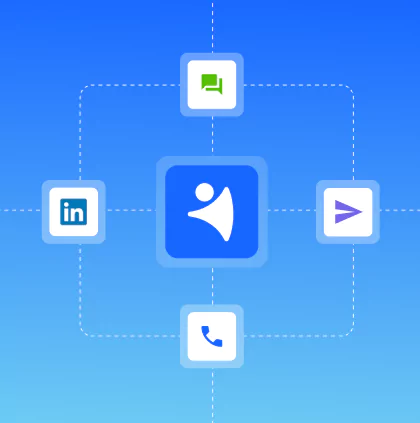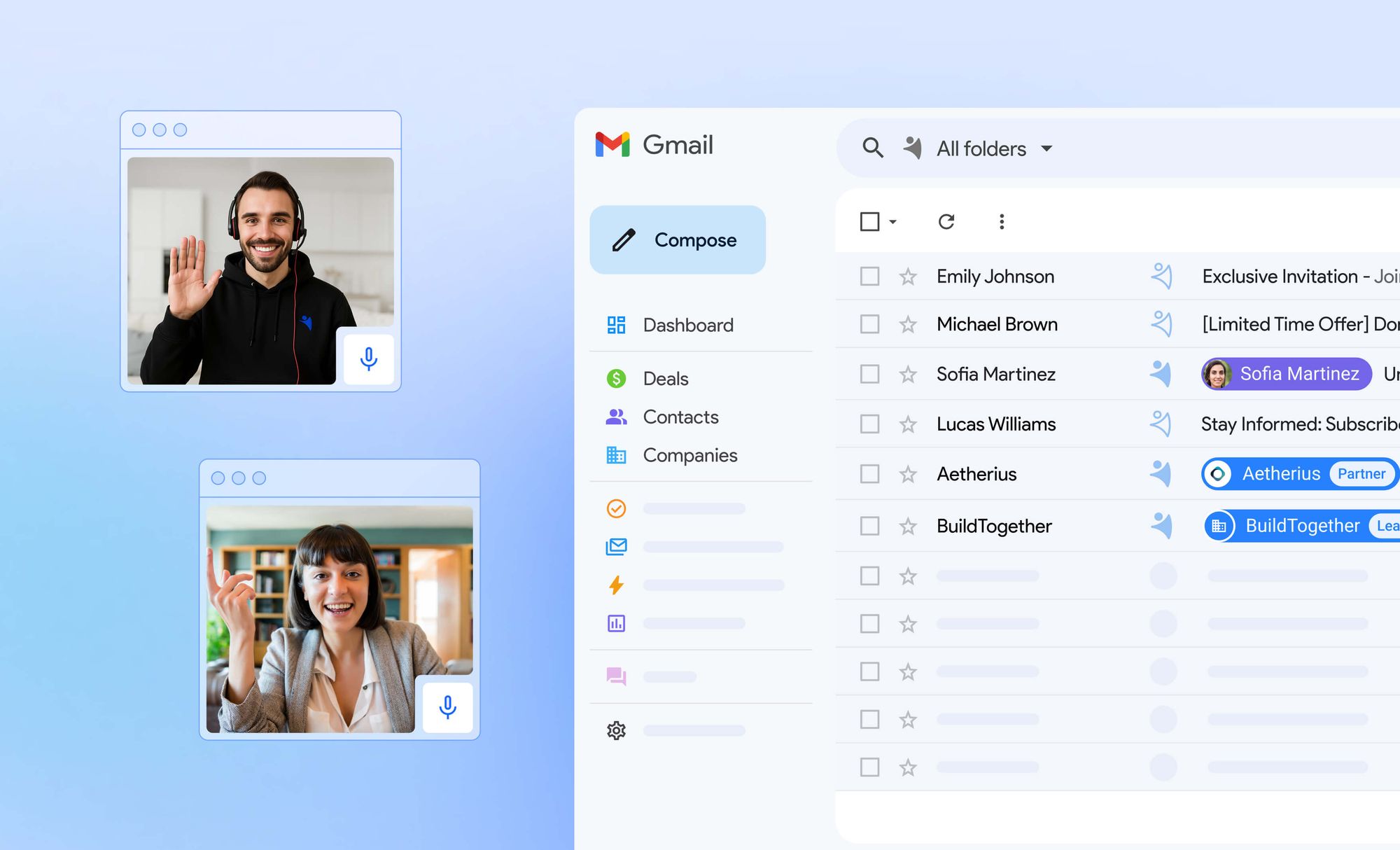Lost after the demo? Here are a few strategies to regain control.
In many cases, what you do after the demo is more important than the demo itself. Why? Because you might misread the entire demo session.
Sure, the lead might be engaged and ask questions during the demo, but what if, in reality, they walk away confused and never advocate for your solution internally? Or worse, what if they switch to your competitor? ?
Here are a few post-demo strategies to stay in control of the deal, reinforce your value, and keep the momentum going — even after the call ends.
#1: Don’t want to demo twice? Re-check the decision-makers at the table
The heart of any lead communication is ensuring you’ve talked to ALL decision-makers in the company from the get-go. Why? Because business decisions no longer happen solo: on average, there are 6-8 decision-makers in the company involved.
Ideally, you want all decision-makers in the first demo so you don’t have to repeat the show for those who’ve missed it. But we understand that sometimes, key players fly under the radar during discovery, whether it’s due to unclear titles, gatekeeping, or sudden changes within the company hierarchy. This means you’ll have to track them down after the demo session. ?
Here is how to do it with the next 5 questions:
- Who else will be involved in making the final decision? This question helps you surface all potential decision-makers early and further tailor your follow-up to each person’s role and needs.
- Is anyone from procurement, finance, or IT going to weigh in? These departments often don’t attend demos but hold veto power, especially around budget, compliance, and security.
- Are there team leads or managers who will need to sign off? Middle managers or department heads may block the decision if they feel left out. What does your internal approval process typically look like? This helps you set realistic expectations as the answer gives you insight into the deal timeline and steps involved.
- Have you bought something similar before? How was that decision made? This question reveals the company’s internal dynamics, who had influence last time, and what obstacles or frustrations came up.
Alright, you've confirmed who's at the table. The next question is what to do if it appears that a few decision-makers are missing?
- If you’ve recorded the call, ask your champion to show the call to those decision-makers who haven’t attended the demo session. Plus, equip your champion to sell internally with the help of valuable resources like presentations, case studies, or tutorials that they can share with other decision-makers within the company.
- Offer an additional demo, but only if it engages the actual decision-makers. Yes, that’s tough, but in some cases, you’ll have to go through one more demo session.
- Don’t have time for another demo session? Ask your lead whether they’ve adopted a similar solution before and what pain points the absent stakeholders have shared in the past. Further, address those pain points in a way that your lead can share your answer (a call recording, case study, etc.).
- Share case studies relevant to each decision-maker’s role. For instance, a CFO will appreciate a case study that shows improved case efficiency, while a case study with a focus on technical reliability and integrations will interest a CFO more.
? Bonus tip: Ask your lead a very simple sincere question: “Who else would be upset if they weren’t in this conversation?”
#2: Replay the conversation and reflect
Pressure, excitement, and multitasking often cloud your memory of what was said, when, and how. If you’ve recorded the call, it is a great opportunity to rewatch & relisten in order to find out the big misses and address them timely with a post-demo follow-up.
While re-listening, take notes on:
- Buying signals or, on the contrary, objections you missed. Further, address them head-on in your follow-up: “"You mentioned integration was a concern. Here's how we handle it…".
- Questions they asked that you didn’t answer clearly. Provide a precise, direct answer in your email, followed by a visual aid or FAQ.
- Reactions to pricing or features — verbal and emotional. Acknowledge hesitation, then reframe the value: “While it may look higher upfront, here’s where clients save in the long run.”
- Opportunities for follow-up value (a whitepaper, case study, feature). Follow up with a whitepaper, one-pager, or tool tailored to their use case. Let’s say they mentioned struggling with onboarding speed. Here, send a case study showing how a similar customer reduced their onboarding time by 40% with the help of your solution.
- Gaps in what you said vs. what they needed to hear. Again, address these moments in your follow-up. Match their goals, not just your features.
? Bonus tip: Use AI transcription tools to speed up your analysis. Use keyword search for “concerns,” “budget,” “timeline,” etc.
#3: Avoid the info dump — stay valuable
Yes, we know you’re too excited to follow up and don't want to waste time. But what happens once you send all the case studies, links to useful blog articles, and feature lists? That all might cause decision paralysis and your lead’s strategy would be to completely avoid any interaction with you for a few days. Doesn’t sound like success to me. ?
Here is how to structure a smart follow-up:
- Make a summary of the call that is short and clear. “Here’s what we discussed…” List 3-5 takeaways + include the recording (if relevant).
- Personalize resources. Send only what’s most relevant to their role and pain points.
- Map the next steps. Set a few dates for the next call to choose from. Further, clarify everything, including who’s responsible for what internally, the decision timeline, possible obstacles, etc.
- Anticipate blockers. Proactively address red flags you noticed during the call, such as pricing pushback, integration concerns, or lack of buy-in.
- Always close with a clear call to action, whether it’s scheduling the next meeting or reviewing a document. Just ensure the next step is obvious and easy to act on.
? Bonus tip: Equip your champion with everything they need as they’re the person rooting for you when you’re not in the room. For instance, give them a short internal pitch deck or a 1-pager they can use to explain your solution to others.
#4: Embrace the comparison conversation
Your lead says they're talking to competitors? Great!
Well… But what if they’ve already talked to your competitor and now are saying that the latter are more efficient, less expensive, etc.? Even better.
Don’t run away from the conversation or rush to a discount. Instead, treat it as an opportunity to outshine your competitor. ?
Here is what to do after the demo if your lead has started the comparison conversation.
- Acknowledge it and show empathy: “Totally makes sense — it’s a big decision!” Such a statement lowers defensiveness and builds trust.
- Ask clarifying questions: “What stood out to you about their offer?” The question is valuable as it tells you what they value most (e.g., speed, integrations, support).
- Clarify differences: “Here’s where we often see customers choose us.” This question helps reframe the conversation around your strengths, not just price or features. For instance, if the competitor focuses on speed but lacks customization, you can say: “While they might onboard teams quickly, we help clients tailor the experience to their exact workflow.”
- Use case studies that show how clients switched from the competitor: It’s a great way to create social proof and de-risk the idea of change. Focus on specific results, like “saved 10 hours/week per user” or “cut churn by 30%,” to make your case stronger.
? Bonus tip: Offer a side-by-side comparison table that makes their internal discussions easier. You can create a “Why Us?” slide or video they can share internally + add testimonials from former customers of the competitor (a pretty sly move, if you ask me, ? but incredibly effective when done respectfully and backed by results).
#5: Handle uncertainty like a pro
Read the room. Sometimes, your leads will leave the meeting cautious or plain overwhelmed. It doesn’t mean your deal is stalled. What it means is that you simply need to guide such leads differently.
Sure, you might be overthinking, “Was it a not-so-firm ‘no’? Does this ‘no’ leave room for more pressure?” ?
Well, here is what to do depending on the type of a lead you’ve got.
- Silent but curious. Send a summary and ask 1-2 pointed questions. It keeps the door open without pressure; “Was this aligned with what you were expecting or is there something we should dig into further?”
- Price-focused. Highlight ROI, time-to-value, and case studies; “Here’s how a similar-sized team saved $X over 6 months.”
- Nervous or skeptical. Offer a short trial or deeper technical session; “Let’s bring your developer in — I can show them how it integrates in under 10 minutes.”
- Distracted decision-maker. Provide a TL;DR version and next-step options; “Here’s a quick summary + 2 slots next week for a short sync. Please let me know what works.”
- ‘Not now’ buyer. Set a calendar reminder and check back with new updates; “Totally get it! I’ll come back in a week with some product updates and relevant use cases that may help with your timing.”
? Bonus tip: Give your lead a bit of ‘homework’ so they stay engaged. Such an approach creates shared accountability and keeps momentum alive: “Let’s both do our prep. You bring any pricing updates or competitive feedback, and I’ll bring a roadmap preview.”
Final thoughts
What happens after a demo defines your conversion rate. When your follow-up is thoughtful, strategic, and aligned with the buyer’s journey, you multiply your chances to close the deal. And the best part is that you don’t have to burn time or over-discount.
Simply put, use our post-sales strategies to build urgency, clarity, and trust. ?
You’ve got it!
FAQ
What should I do after a demo?
After a demo, your goal is to reinforce your value, clarify next steps, and maintain control of the sales process. Here is what you should do:
- Review the call recording or notes and look for moments where the lead showed interest or asked insightful questions;
- Send a tailored follow-up email where you include a summary of the conversation and answers to any open questions;
- Attach valuable resources, such as case studies or a one-pager that directly address their pain points;
- Outline next steps: propose a timeline, a follow-up meeting, or the decision-making process you expect.
How to follow up after a demo session?
Here is how to craft a powerful post-demo message:
- Keep it short and structured. Break your message into clear sections, such as summary (where you recap the conversation), valuable resources (case studies, articles, and others), and next steps.
- Set clear expectations. Define what happens next: this can be a pricing discussion, internal review, or another call.
- Offer availability. Suggest a few time slots for the next meeting or check-in.
What comes after a demo?
What happens after a demo can make or break the deal. Here’s what typically comes after:
- Follow-up communication. This is where you send a personalized recap email with resources and proposed next steps. During this step, you can also send valuable resources to the champion to help them sell your solution internally.
- Decision-maker alignment. Identify and engage anyone who hasn’t yet seen the product or asked questions.
- Handle objections and comparisons. Proactively address any concerns that might have occurred during the demo session.
- Map the deal progression. Collaborate with your team and lead on timelines, approval steps, and any procurement stages.
What do sales managers do after a demo?
Sales managers turn insights into strategy and support reps in closing deals. Here is what sales managers can do:
- Review the demo and debrief with the rep. Discuss what went well, what felt off, and whether follow-up steps are clear;
- Provide valuable materials which reps can pass to champions for better internal selling;
- Ensure everyone understands the deal stage, blockers, and potential close date;
- Adjust pipeline forecasts based on the demo outcomes;
- Offer strategic advice on messaging, competitive positioning, and stakeholder handling.




















 product experts — let's find the best setup for your team
product experts — let's find the best setup for your team